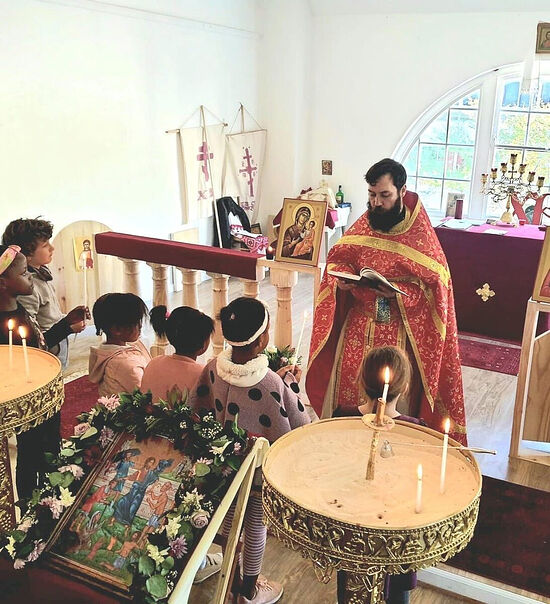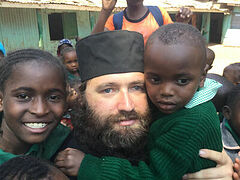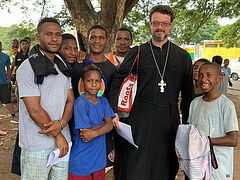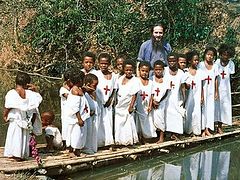In early November 2023, we talked with Fr. Nicholas Esterhuisen, rector of the Church of St. John of the Ladder in Cape Town, who spoke about the special challenges of having a mission of the Russian Orthodox Church in Africa.
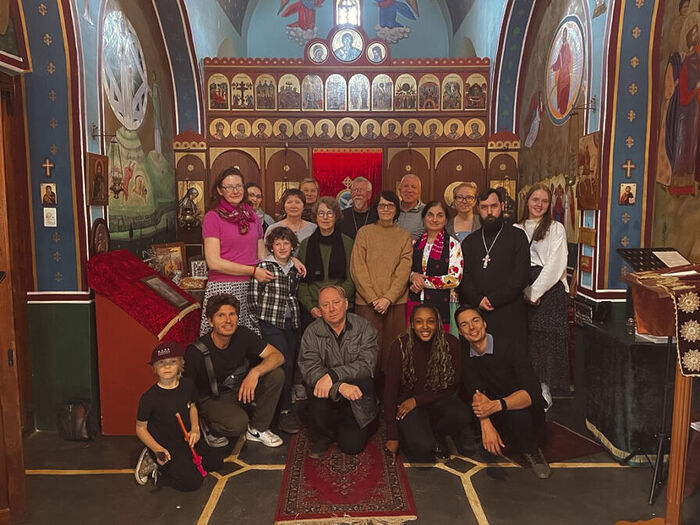 Parishioners of the Church of St. John of the Ladder inside the St. Mary of Egypt Church (South Africa). Photo: exarchate-africa.ru
Parishioners of the Church of St. John of the Ladder inside the St. Mary of Egypt Church (South Africa). Photo: exarchate-africa.ru
“Our goal is to be in a canonical Church”
—Could you tell us what predated the transfer of your parish? What was it like to serve under the jurisdiction of the Patriarchate of Alexandria and what prompted you to transfer to the Moscow Patriarchate?
—I am a native of South Africa. My father is Dutch and my mother is British. My wife is Russian. I converted to Orthodoxy from Protestantism. I studied at the Saint Tikhon’s Orthodox University of the Humanities in Russia, but I didn’t complete the full course there, and I also studied in the Russian Orthodox Church Abroad. Prior to that, I studied painting at the Academy of Arts in St. Petersburg. I served with the Greeks in a church of the Patriarchate of Alexandria, as it was the only Orthodox church in Cape Town. I started as an altar boy and later became a deacon and then a priest.
Of course, that is also an Orthodox Church, but it doesn’t have that missionary spirit, and so I felt a bit sad there that it wasn’t open to all. The priests and hierarchs of the Church often served nationalistic interests and showed little pastoral care for the non-Greek parishioners. Some people would visit and express their desire to become Orthodox, but the Greeks didn’t know what to do with them. We heard a lot of complaints like that, especially in Tanzania, Kenya, and Zambia. Under Alexandria, we were losing the chance to start a mission the way the Russians are doing these days.
When the Church of Alexandria voiced their support of schismatics in Ukraine, we decided that this was wrong and that we wanted to be a canonical Orthodox Church. People who convert to Orthodoxy from Catholicism and Protestantism expect exactly that. They don’t want to end up in a schismatic Church. Therefore, it was easy for us to make this choice, and we transferred to the Russian Orthodox Church as a congregation.
—Who makes up the backbone of your parish, and what languages do you use for worship?
We are a missionary church and there are many new converts
—It often happens that ROC churches abroad are designed primarily to suit the needs of the Russian diaspora. But it’s a little different here—we are a missionary church with many new converts. The locals make up sixty percent of our parish, with only forty percent Russians. Many Russians visit and live in Cape Town; there are eight thousand of them here, but only about thirty of them attend church on a regular basis. Just like in Russia, I guess.
We conduct services in English and Church Slavonic, but we also try to add other languages, such as Xhosa and Afrikaans. This way, everyone will hear their native language during the service and realize that Orthodoxy is their faith as well, and that you don’t have to become Russian to be Orthodox.
At the same time, almost everyone here loves the names of Russian saints and chooses them when they are baptized into Orthodoxy. Although there are exceptions; for example, one of our European parishioners accepted the name of St. Moses the Ethiopian—just because he is a saint. His skin color didn’t matter.
Intensive catechization is a specific feature of our parish, because people come from Protestantism and Catholicism, and they want to know more about Orthodoxy.
Mission in South Africa
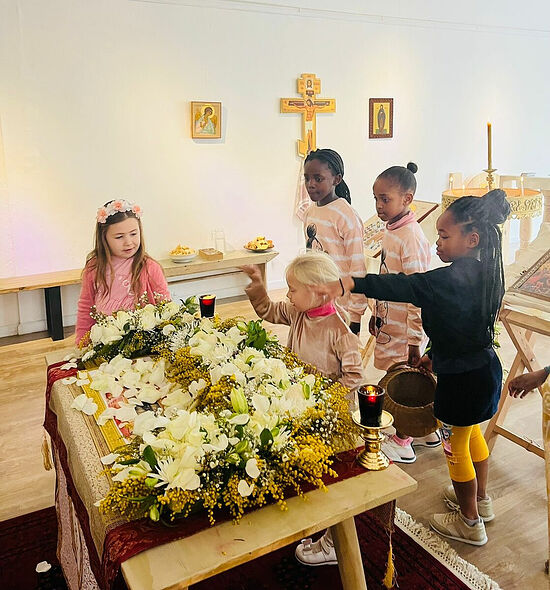 Decorating for the feast of the Dormition of the Most Holy Mother of God in the Church of St. John of the Ladder in Cape Town. Photo: exarchate-africa.ru
Decorating for the feast of the Dormition of the Most Holy Mother of God in the Church of St. John of the Ladder in Cape Town. Photo: exarchate-africa.ru
—Tell us about your missionary work. What are the specifics of having a mission in Africa?
—Our first priority is building a church, a community. We don’t walk around Cape Town holding up posters saying, “Orthodoxy is the best faith!” What lies at the root of our mission is our own Christian life. We should have love among each other, we should feel reverence at services, and we must preach the Apostolic Christian faith through our liturgical tradition and the Sacraments of the Church.
People feel that there is something missing in their Christian confessioin, so they study the history of the Church and then realize that Orthodoxy is the true faith. They come for a visit and we have to have a place for them. Of course, there is some misunderstanding at first. Many people, for example, are scared when they see the icons—there is nothing like that in Protestantism. I have to explain that this is the true ancient Christian tradition.
The exarchate has existed for only two years in Africa, but many churches and priests have already transferred to the ROC. The missionary work is going at a much livelier and faster rate than what the Greeks had done in a hundred years. We were invited to visit Limpopo (a region of South Africa) next month by a community that wants to convert to Orthodoxy. We will catechize there. They have a pastor there, he wants to be Orthodox, and he is ready to bring people and pray together.
Every Thursday we have online catechesis course for people from all over South Africa
Every Thursday night we have online catechesis course for people from all over South Africa. We have the Orthodox and Protestants there, generally, for anyone interested.
—Apart from worship and catechization, do you organize any events?
—Once a month, after the service we have an hour of Sunday school and teatime; then we have a hike in the mountains. As we go, we teach lessons and read prayers, so that the church life would be present everywhere, not just at church. We serve an Akathist on Wednesdays. At Christmas, we had a fair and a concert. On Theophany, all the Orthodox faithful gather by the ocean. In this we follow the Greek, [Serbian], and Bulgarian tradition—the cross is thrown far into the waves and the parishioners have to swim far to get it.
In November of next year, we will hold a children’s Orthodox camp for five days. We have about twenty children and teenagers. There may be another thirty or so coming from Johannesburg. It will be held on a farm about a one-and-a-half hours’ drive from here. We’re building a little chapel there in honor of the Transfiguration of the Lord. We have several people who are going to take monastic vows, including Moses, whom I mentioned earlier. They will travel to a monastery in Russia and, God willing, they will return here. And this particular church is intended to be a monastery in the future.
Dome-free
—Speaking of the church. It is very difficult to find it, if you don’t know its exact location. It looks like an ordinary cafe. Do you have random people popping in? Say, tourists, like Russians?
 Sketch of a church —Please note the cafe is called, “The ladder.” Sure, we do have some random people visiting the cafe, they see me in my cassock, learn that there is a church over their heads, and get truly surprised. Maybe when we erect the golden domes it will attract more people. But you know, we don’t want the church to be seen simply as a cultural landmark. We’re looking for people who want to transform their lives. Currently, there is only one Russian Orthodox church here in South Africa that already looks like a Russian church with domes—it is the Church of St. Sergius of Radonezh in Johannesburg. We also have plans to add the domes; we even have a rough draft already.
Sketch of a church —Please note the cafe is called, “The ladder.” Sure, we do have some random people visiting the cafe, they see me in my cassock, learn that there is a church over their heads, and get truly surprised. Maybe when we erect the golden domes it will attract more people. But you know, we don’t want the church to be seen simply as a cultural landmark. We’re looking for people who want to transform their lives. Currently, there is only one Russian Orthodox church here in South Africa that already looks like a Russian church with domes—it is the Church of St. Sergius of Radonezh in Johannesburg. We also have plans to add the domes; we even have a rough draft already.
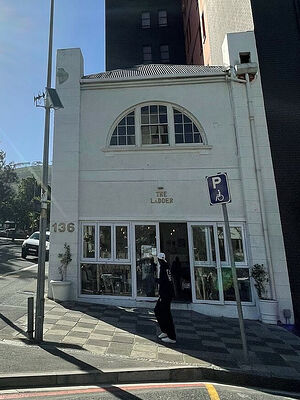 “The Ladder” Cafe In the meantime, we want to add a mosaic, an icon and a small cross over the side entrance so that people don’t get lost. Because right now no one understands where the church is. We want to add African motifs to the frescoes and the mosaic above the entrance that would actually allude to the fact that we are in Africa. We don’t want to lose this place. Even though it’s small, it’s right in the center of the city. We’ll close the cafe, turn it into a refectory, like in the monasteries. But it will happen later.
“The Ladder” Cafe In the meantime, we want to add a mosaic, an icon and a small cross over the side entrance so that people don’t get lost. Because right now no one understands where the church is. We want to add African motifs to the frescoes and the mosaic above the entrance that would actually allude to the fact that we are in Africa. We don’t want to lose this place. Even though it’s small, it’s right in the center of the city. We’ll close the cafe, turn it into a refectory, like in the monasteries. But it will happen later.
At this point, this cafe is our support, and thanks to it I can at least not ask my parishioners to fund my salary. On the one hand, it is good that I am a working priest, and like everyone else, I have the same problems as my parishioners and understand them. On the other hand, my parishioners suffer, because since I work in the café, I have less time left for missionary trips, to prepare for catechesis and communicate with them.
What is church life like?
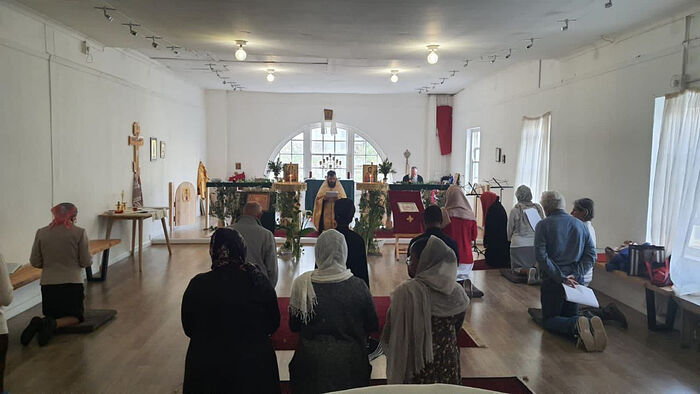 Worship at the Church of St. John of the Ladder in Cape Town. Photo: Patriarchal Exarchate of Africa
Worship at the Church of St. John of the Ladder in Cape Town. Photo: Patriarchal Exarchate of Africa
—How does the parish support itself? What does it lack? It’s so easy to purchase liturgical items in Russia—but here?
—Well-wishers from Russia and Ukraine bring necessary things: incense, candleholders, and so on. We appreciate what we have, because it is so hard to get it. Vladyka Leonid, our former Exarch, gave us a Eucharistic set: discos, Chalice, the Communion spoon, and altar cross. This helped us to jumpstart our mission.
 In general, the Exarchate supports priests throughout Africa with small stipends. We use this money for the needs of the church. Besides, every parishioner makes an effort to donate at least a little bit to his parish, and we use this money to continue the construction of a chapel on a farm and order the icons.
In general, the Exarchate supports priests throughout Africa with small stipends. We use this money for the needs of the church. Besides, every parishioner makes an effort to donate at least a little bit to his parish, and we use this money to continue the construction of a chapel on a farm and order the icons.
We have Xenia, our very talented icon painter who paints icons on a charitable basis, because it is so expensive to bring them from Russia. She is Russian from Zvenigorod, and she has been living here for ten years. She painted many of the icons in our church. But for the most part, our icons were donations made by people who reside here. We built our iconostasis ourselves.
I also made the Analogions myself. They may be a little uneven, but that’s fine. We have candles donated to us; the Ukrainians bring us many them from Ukraine, but we will make them ourselves once we have our monastery. What is missing? Service books in English, vestments for altar boys and sticharia. A square candleholder for the remembrance of the dead. And the golden domes, of course (laughs). But those can wait, I guess.


